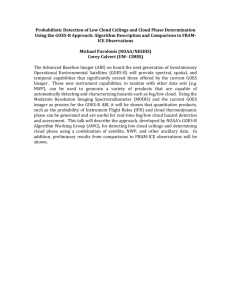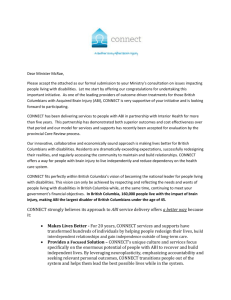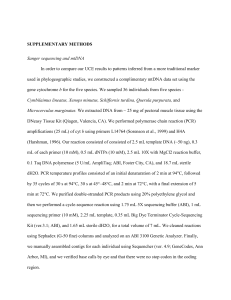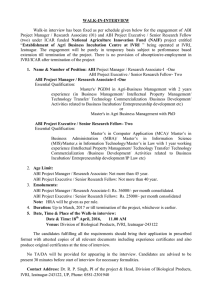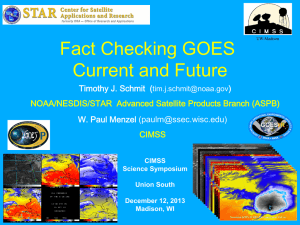Preparing for the GOES-R by using GOES-14 1-min imagery
advertisement
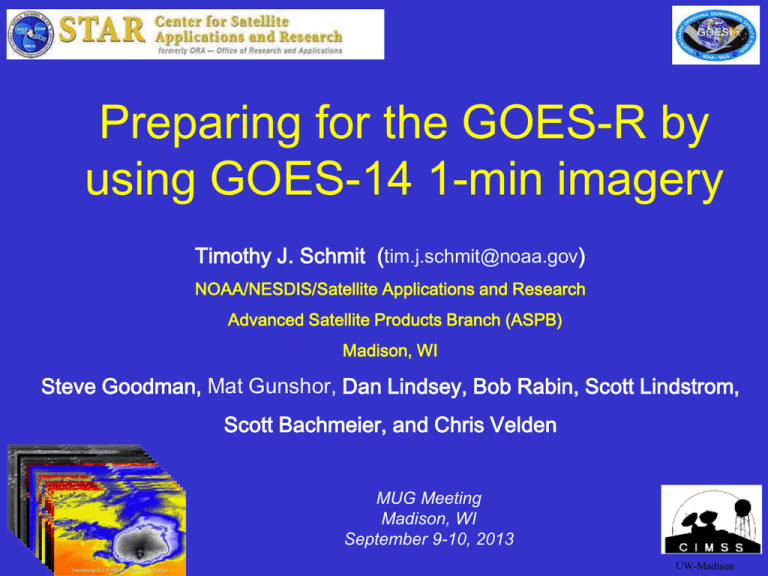
Preparing for the GOES-R by using GOES-14 1-min imagery Timothy J. Schmit (tim.j.schmit@noaa.gov) NOAA/NESDIS/Satellite Applications and Research Advanced Satellite Products Branch (ASPB) Madison, WI Steve Goodman, Mat Gunshor, Dan Lindsey, Bob Rabin, Scott Lindstrom, Scott Bachmeier, and Chris Velden MUG Meeting Madison, WI September 9-10, 2013 1 UW-Madison Thanks to… • Justin Sieglaff and John Cintineo • Kevin Ludlum, GOES operators, GOES shift supervisors, etc. • Dave Radell, Frank Alsheimer, Andy Edman, Joleen Feltz, William Straka, Jun Li, Steve Ackerman, Bob Aune, Paul Menzel, Tony Schreiner, Jim Jung, Elaine Prins, Brad Pierce, Wayne Feltz, Jean Phillips, Gary Wade, Don Hillger, Jinlong Li, Jing Zheng, Allen Huang, the SSEC Data Center, Mike Pavolonis, Michael Folmer, Jaime Daniels, ASPB, STAR, NESDIS, NSSL, MUG, Mark DeMaria, and many others! • GOES-R Program Office, NASA, ITT Industries, other industry partners, etc. • You. 2 Outline • ABI (Advanced Baseline Imager) – Spectral – Spatial – Temporal • Summary – More information – Questions 3 GOES-R main instruments ABI – Advanced Baseline Imager Space Weather/Solar ABI covers the earth approximately five times faster than the current Imager. Geostationary Lightning Mapper Images courtesy of SOHO EIT, a joint NASA/ESA program 4 GOES-R Overview • Advanced Baseline Imager (ABI) – No dedicated Sounder • Geostationary Lightning Mapper (GLM) • Space Weather – – – – Space Environmental In-Situ Suite (SEISS) Solar Ultra Violet Imager (SUVI) Extreme Ultra Violet/X-Ray Irradiance Sensor (EXIS) Magnetometer • Communications – – – – – GOES Rebroadcast (GRB) Low Rate Information Transmissions (LRIT) Emergency Managers Weather Information Network (EMWIN) Search and Rescue (SAR) Data Collection System (DCS) 5 GOES Fly-out Schedule Outline • ABI (Advanced Baseline Imager) – Spectral – Spatial – Temporal • Summary – More information – Questions Lockheed Martin 7 The Advanced Baseline Imager: ABI Current 16 bands 5 bands Spatial resolution 0.64 µm Visible Other Visible/near-IR Bands (>2 µm) 0.5 km 1.0 km 2 km Approx. 1 km n/a Approx. 4 km Spatial coverage Full disk CONUS Mesoscale 4 per hour 12 per hour Every 30 sec Scheduled (3 hrly) ~4 per hour n/a Visible (reflective bands) On-orbit calibration Yes No Spectral Coverage 8 ABI Visible/Near-IR Bands 9 Schmit et al, 2005 ABI IR Bands 10 Schmit et al, 2005 Visible and near-IR channels on the ABI Sample use only, many other uses The ABI visible and near-IR bands have many uses. 11 The IR channels on the ABI Sample use only, many other uses 12 ABI has many more bands than the current operational GOES imagers. 0.64 µm 3.9 µm 6.95 µm 11.2 µm 13.3 µm ABI band selection 0.47 µm 1.61 µm 0.64 µm 2.26 µm 0.86 µm 3.9 µm 6.95 µm 7.34 µm 8.5 µm 10.35 µm 11.2 µm 12.3 µm 1.38 µm 6.19 µm 9.61 µm 13.3 µm ABI scans about 5 times faster than the current GOES imager Anticipated scan mode for the ABI: - Full disk images every 15 minutes + 5 min CONUS images + mesoscale.18 ABI can offer Continental US images every 5 minutes for routine monitoring of a wide range of events (storms, dust, clouds, fires, winds, etc). 19 This is every 15 or 30 minutes with the current GOES in routine mode. 20 Mesoscale images every 30 seconds for rapidly changing phenomena 21 (thunderstorms, hurricanes, fires, etc). Or two regions every 60 seconds. GOES-14: Special Rapid Scanning offers glimpse of the ABI • • • • • SRSOR (Super Rapid Scan Operations for GOES-R) from GOES-14 imager Data between mid-August and September 24th and late October 2012; and two days in June and 12 days in mid-August, 2013. http://cimss.ssec.wisc.edu/ goes/srsor/GOES14_SRSOR.html and http://cimss.ssec.wisc.edu/ goes/srsor2013/GOES14_SRSOR.html Many phenomena were observed: convection, hurricanes, fires, smoke, ... Data to many groups HPC, OPC, AWC, SPC, SAB, several regions, etc. Animation from GOES-14 Imager visible image at 1-min time resolution. GOES-14 provided very unique information and offers a glimpse into the possibilities that will be provided by the ABI on GOES-R. http://cimss.ssec.wisc.edu/goes/srsor/GOES-14_SRSOR.html SRSOR 24 Rate of temporal cooling in the longwave infrared band Cintineo et al., 2013 (CIMSS) 25 http://cimss.ssec.wisc.edu/goes/srsor2013/GOES-14_SRSOR.html 26 1-min imagery 1-min mode (SRSOR from GOES-14) Operational (GOES-13) 27 SRSOR (2013) 28 Outline • ABI (Advanced Baseline Imager) – Spectral – Spatial – Temporal • Summary – More information – Questions 29 Approximate spectral and spatial resolutions of US GOES Imagers Visible ~ Band Center (um) GOES-6/7 GOES-8/11 GOES-12/N GOES-O/P GOES-R+ 0.47 0.64 Near-IR 0.86 1.6 Box size represents pixel size 1.38 2.2 3.9 6.2 Infrared 6.5/6.7/7 7.3 8.5 9.7 10.35 11.2 12.3 13.3 14km “MSI mode” 8 4 2 Summary 1. The GOES-R ABI provides mission continuity 2. Two times the image navigation quality 3. Three times the number of imaging bands 4. Four times the spatial resolutions 5. Five times the coverage rate - Special GOES-14 1-min data pathfinder 31 GOES-R ABI Products Baseline Products Future Capabilities Advanced Baseline Imager (ABI) Advanced Baseline Imager (ABI) Aerosol Detection (Including Smoke and Dust) Aerosol Optical Depth (AOD) Clear Sky Masks Cloud and Moisture Imagery Cloud Optical Depth Cloud Particle Size Distribution Cloud Top Height Cloud Top Phase Cloud Top Pressure Cloud Top Temperature Derived Motion Winds Derived Stability Indices Downward Shortwave Radiation: Surface Fire/Hot Spot Characterization Hurricane Intensity Estimation Land Surface Temperature (Skin) Legacy Vertical Moisture Profile Legacy Vertical Temperature Profile Radiances Rainfall Rate/QPE Reflected Shortwave Radiation: TOA Sea Surface Temperature (Skin) Snow Cover Total Precipitable Water Volcanic Ash: Detection and Height Absorbed Shortwave Radiation: Surface Aerosol Particle Size Aircraft Icing Threat Cloud Ice Water Path Cloud Layers/Heights Cloud Liquid Water Cloud Type Convective Initiation Currents Currents: Offshore Downward Longwave Radiation: Surface Enhanced “V”/Overshooting Top Detection Flood/Standing Water Ice Cover Low Cloud and Fog Ozone Total Probability of Rainfall Rainfall Potential Sea and Lake Ice: Age Sea and Lake Ice: Concentration Sea and Lake Ice: Motion Snow Depth (Over Plains) SO2 Detection Surface Albedo Surface Emissivity Tropopause Folding Turbulence Prediction Upward Longwave Radiation: Surface Upward Longwave Radiation: TOA Vegetation Fraction: Green Vegetation Index Visibility More information GOES-R: • http://www.goes-r.gov • http://www.meted.ucar.edu/index.htm UW/SSEC/CIMSS/ASPB: • http://cimss.ssec.wisc.edu/goes_r/proving-ground.html • (ABI WES guide with simulated images) • http://cimss.ssec.wisc.edu/goes_r/provingground/nssl_abi/nssl_abi_rt.html AMS BAMS Article on the ABI • http://cimss.ssec.wisc.edu/goes_r/provingground/wrf_chem_abi/wrf_chem_abi.html • http://cimss.ssec.wisc.edu/goes/abi/ • http://cimss.ssec.wisc.edu/goes/blog/ • http://cimss.ssec.wisc.edu/goes/srsor/GOES14_SRSOR.html • http://cimss.ssec.wisc.edu/goes/srsor2013/GOES14_SRSOR.html GOES + RTC (Roof Top Cameras) Timothy J. Schmit (tim.j.schmit@noaa.gov) NOAA/NESDIS/Satellite Applications and Research Advanced Satellite Products Branch (ASPB) Madison, WI Philipp Ratz, Bill Bellon, W. Paul Menzel CIMSS MUG Meeting Madison, WI September 9-10, 2013 35 UW-Madison GOES-14 SRSOR + RTC http://cimss.ssec.wisc.edu/goes/rtc The 1-min interval imagery shows ‘what is happening’, not ‘what has happened’. GOES-13 SRSOR + RTC http://cimss.ssec.wisc.edu/goes/rtc_goes_east/ National/International examples? You build a page with GOES and RTC and I’ll link to it…
